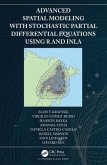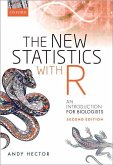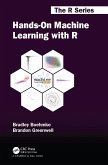Pablo Inchausti (Professor of Ecology, Professor of Ecology, Univer
Statistical Modeling With R
a dual frequentist and Bayesian approach for life scientists
Pablo Inchausti (Professor of Ecology, Professor of Ecology, Univer
Statistical Modeling With R
a dual frequentist and Bayesian approach for life scientists
- Broschiertes Buch
- Merkliste
- Auf die Merkliste
- Bewerten Bewerten
- Teilen
- Produkt teilen
- Produkterinnerung
- Produkterinnerung
An accessible textbook that explains, discusses, and applies both the frequentist and Bayesian theoretical frameworks to fit the different types of statistical models that allow an analysis of the types of data most commonly gathered by life scientists.
Andere Kunden interessierten sich auch für
![Statistical Studies of Income, Poverty and Inequality in Europe Statistical Studies of Income, Poverty and Inequality in Europe]() Nicholas T. LongfordStatistical Studies of Income, Poverty and Inequality in Europe48,99 €
Nicholas T. LongfordStatistical Studies of Income, Poverty and Inequality in Europe48,99 €![Advanced Spatial Modeling with Stochastic Partial Differential Equations Using R and INLA Advanced Spatial Modeling with Stochastic Partial Differential Equations Using R and INLA]() Elias Krainski (Universidade Federal do Parana, Curitivba, Brazil)Advanced Spatial Modeling with Stochastic Partial Differential Equations Using R and INLA149,99 €
Elias Krainski (Universidade Federal do Parana, Curitivba, Brazil)Advanced Spatial Modeling with Stochastic Partial Differential Equations Using R and INLA149,99 €![The New Statistics with R The New Statistics with R]() Andy Hector (Professor of Ecology, Professor of Ecology, DepartmentThe New Statistics with R42,99 €
Andy Hector (Professor of Ecology, Professor of Ecology, DepartmentThe New Statistics with R42,99 €![Statistical Rethinking Statistical Rethinking]() Richard McElreath (Max Planck Institute for Evolutionary AnthropoloStatistical Rethinking95,99 €
Richard McElreath (Max Planck Institute for Evolutionary AnthropoloStatistical Rethinking95,99 €![Statistical Learning Using Neural Networks Statistical Learning Using Neural Networks]() Basilio de Braganca PereiraStatistical Learning Using Neural Networks53,99 €
Basilio de Braganca PereiraStatistical Learning Using Neural Networks53,99 €![Computational Statistical Physics Computational Statistical Physics]() Lucas BoettcherComputational Statistical Physics84,99 €
Lucas BoettcherComputational Statistical Physics84,99 €![Hands-On Machine Learning with R Hands-On Machine Learning with R]() Brad BoehmkeHands-On Machine Learning with R115,99 €
Brad BoehmkeHands-On Machine Learning with R115,99 €-
-
-
An accessible textbook that explains, discusses, and applies both the frequentist and Bayesian theoretical frameworks to fit the different types of statistical models that allow an analysis of the types of data most commonly gathered by life scientists.
Hinweis: Dieser Artikel kann nur an eine deutsche Lieferadresse ausgeliefert werden.
Hinweis: Dieser Artikel kann nur an eine deutsche Lieferadresse ausgeliefert werden.
Produktdetails
- Produktdetails
- Verlag: Oxford University Press
- Seitenzahl: 480
- Erscheinungstermin: 2. November 2022
- Englisch
- Abmessung: 244mm x 190mm x 26mm
- Gewicht: 1082g
- ISBN-13: 9780192859020
- ISBN-10: 0192859021
- Artikelnr.: 64102662
- Herstellerkennzeichnung
- Libri GmbH
- Europaallee 1
- 36244 Bad Hersfeld
- gpsr@libri.de
- Verlag: Oxford University Press
- Seitenzahl: 480
- Erscheinungstermin: 2. November 2022
- Englisch
- Abmessung: 244mm x 190mm x 26mm
- Gewicht: 1082g
- ISBN-13: 9780192859020
- ISBN-10: 0192859021
- Artikelnr.: 64102662
- Herstellerkennzeichnung
- Libri GmbH
- Europaallee 1
- 36244 Bad Hersfeld
- gpsr@libri.de
Pablo Inchausti is Professor of Ecology at the Universidad de la República, Centro Universitario Regional del Este, Uruguay. He is the co-editor of the influential and highly-cited book Biodiversity and Ecosystem Functioning: synthesis and perspectives (OUP, 2002) and has been successfully teaching statistics and mathematical modelling to students of the life and social sciences for over 15 years.
* Part 1: The Conceptual Basis For Fitting Statistical Models
* 1: General introduction
* 2: Statistical modeling: a short historical background
* 3: Estimating parameters: the main purpose of statistical inference
* Part II: Applying The Generalized Linear Model to Varied Data Types
* 4: The General Linear Model I: numerical explanatory variables
* 5: The General Linear Model II: categorical explanatory variables
* 6: The General Linear Model III: interactions between explanatory
variables
* 7: Model selection: one, two, and more models fitted to the data
* 8: The Generalized Linear Model
* 9: When the response variable is binary
* 10: When the response variables are counts, often with many zeros
* 11: Further issues involved in the modeling of counts
* 12: Models for positive real-valued response variables: proportions
and others
* Part III: Incorporating Experimental and Survey Design Using Mixed
Models
* 13: Accounting for structure in mixed/hierachical structures
* 14: Experimental design in the life sciences - the basics
* 15: Mixed-hierachical models and experimental design data
* Afterword
* R packages used in the book
* Appendix 1: Using R and RStudio: the basics (only available online at
www.oup.com/companion/InchaustiSMWR)
* Appendix 2: Exploring and describing the evidence in graphics (only
available online at www.oup.com/companion/InchaustiSMWR)
* 1: General introduction
* 2: Statistical modeling: a short historical background
* 3: Estimating parameters: the main purpose of statistical inference
* Part II: Applying The Generalized Linear Model to Varied Data Types
* 4: The General Linear Model I: numerical explanatory variables
* 5: The General Linear Model II: categorical explanatory variables
* 6: The General Linear Model III: interactions between explanatory
variables
* 7: Model selection: one, two, and more models fitted to the data
* 8: The Generalized Linear Model
* 9: When the response variable is binary
* 10: When the response variables are counts, often with many zeros
* 11: Further issues involved in the modeling of counts
* 12: Models for positive real-valued response variables: proportions
and others
* Part III: Incorporating Experimental and Survey Design Using Mixed
Models
* 13: Accounting for structure in mixed/hierachical structures
* 14: Experimental design in the life sciences - the basics
* 15: Mixed-hierachical models and experimental design data
* Afterword
* R packages used in the book
* Appendix 1: Using R and RStudio: the basics (only available online at
www.oup.com/companion/InchaustiSMWR)
* Appendix 2: Exploring and describing the evidence in graphics (only
available online at www.oup.com/companion/InchaustiSMWR)
* Part 1: The Conceptual Basis For Fitting Statistical Models
* 1: General introduction
* 2: Statistical modeling: a short historical background
* 3: Estimating parameters: the main purpose of statistical inference
* Part II: Applying The Generalized Linear Model to Varied Data Types
* 4: The General Linear Model I: numerical explanatory variables
* 5: The General Linear Model II: categorical explanatory variables
* 6: The General Linear Model III: interactions between explanatory
variables
* 7: Model selection: one, two, and more models fitted to the data
* 8: The Generalized Linear Model
* 9: When the response variable is binary
* 10: When the response variables are counts, often with many zeros
* 11: Further issues involved in the modeling of counts
* 12: Models for positive real-valued response variables: proportions
and others
* Part III: Incorporating Experimental and Survey Design Using Mixed
Models
* 13: Accounting for structure in mixed/hierachical structures
* 14: Experimental design in the life sciences - the basics
* 15: Mixed-hierachical models and experimental design data
* Afterword
* R packages used in the book
* Appendix 1: Using R and RStudio: the basics (only available online at
www.oup.com/companion/InchaustiSMWR)
* Appendix 2: Exploring and describing the evidence in graphics (only
available online at www.oup.com/companion/InchaustiSMWR)
* 1: General introduction
* 2: Statistical modeling: a short historical background
* 3: Estimating parameters: the main purpose of statistical inference
* Part II: Applying The Generalized Linear Model to Varied Data Types
* 4: The General Linear Model I: numerical explanatory variables
* 5: The General Linear Model II: categorical explanatory variables
* 6: The General Linear Model III: interactions between explanatory
variables
* 7: Model selection: one, two, and more models fitted to the data
* 8: The Generalized Linear Model
* 9: When the response variable is binary
* 10: When the response variables are counts, often with many zeros
* 11: Further issues involved in the modeling of counts
* 12: Models for positive real-valued response variables: proportions
and others
* Part III: Incorporating Experimental and Survey Design Using Mixed
Models
* 13: Accounting for structure in mixed/hierachical structures
* 14: Experimental design in the life sciences - the basics
* 15: Mixed-hierachical models and experimental design data
* Afterword
* R packages used in the book
* Appendix 1: Using R and RStudio: the basics (only available online at
www.oup.com/companion/InchaustiSMWR)
* Appendix 2: Exploring and describing the evidence in graphics (only
available online at www.oup.com/companion/InchaustiSMWR)








